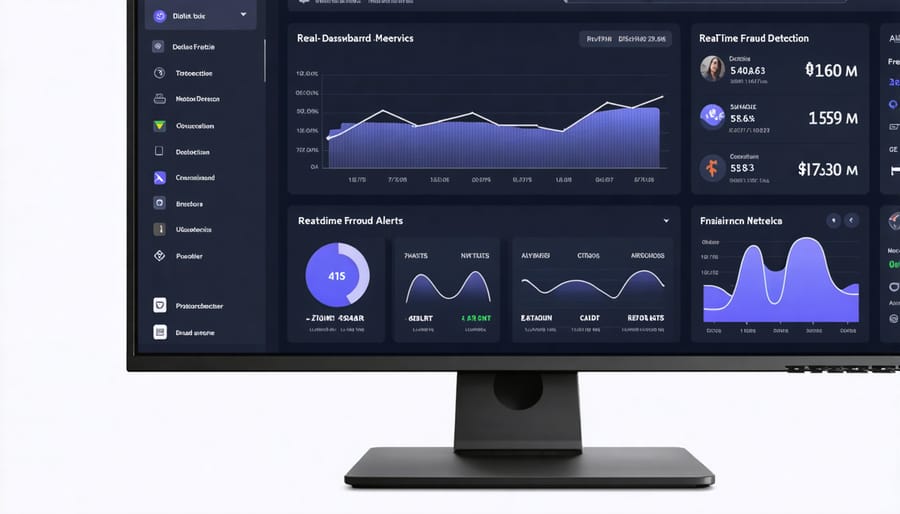Artificial Intelligence is revolutionizing the financial sector, transforming everything from personal banking to global markets with unprecedented precision and efficiency. Today’s financial institutions leverage explainable AI in fraud detection, predictive analytics, and automated trading systems to stay competitive in an increasingly digital marketplace. By processing vast amounts of financial data in real-time, AI algorithms can identify patterns, predict market trends, and detect fraudulent activities with remarkable accuracy – capabilities that were unimaginable just a decade ago.
From algorithmic trading platforms that execute millions of transactions per second to intelligent chatbots providing 24/7 customer service, AI applications are becoming integral to modern financial operations. These technologies not only enhance operational efficiency but also improve risk management, reduce costs, and create more personalized financial services for consumers.
The integration of AI in finance isn’t just about automation – it’s about augmenting human decision-making with data-driven insights, enabling financial institutions to make smarter, faster, and more informed choices while maintaining regulatory compliance and security standards.
How AI Transforms Financial Fraud Detection

Real-Time Transaction Monitoring
In today’s fast-paced financial world, AI systems serve as vigilant guardians, continuously monitoring millions of transactions in real-time to protect against fraud and financial crimes. These sophisticated systems use advanced machine learning algorithms to establish baseline patterns of normal transaction behavior and quickly flag any deviations that might indicate fraudulent activity.
For example, when you swipe your card at a store, AI analyzes dozens of data points within milliseconds: the location, amount, merchant type, and your typical spending patterns. This technology has revolutionized debit card fraud prevention by catching suspicious activities before they can cause significant damage.
The AI monitoring system works by creating a unique financial fingerprint for each customer. It learns from your regular transaction patterns – where you shop, when you typically make purchases, and your average transaction amounts. When something doesn’t fit this pattern, like a large purchase in a different country or multiple transactions in quick succession, the AI flags it for review.
Modern AI systems can also detect subtle patterns that might escape human notice. They can identify coordinated fraud attempts across multiple accounts, recognize emerging fraud schemes, and adapt their detection methods in response to new threats. This dynamic learning capability means the system becomes more effective over time.
Financial institutions have reported significant improvements in fraud detection rates and reduced false positives since implementing AI-powered monitoring systems. This not only saves banks millions in fraud losses but also improves customer experience by reducing unnecessary transaction declines while maintaining robust security.
Pattern Recognition and Anomaly Detection
AI’s pattern recognition capabilities have revolutionized how financial institutions detect and respond to unusual activities. By analyzing vast amounts of transaction data in real-time, AI systems can quickly identify behavioral patterns that deviate from the norm, potentially indicating fraud or other suspicious activities.
These systems work by establishing baseline patterns for normal financial behavior, such as typical transaction amounts, frequency of trades, and common geographic locations. When transactions fall outside these established patterns, the AI flags them for review. For example, if a customer who usually makes small local purchases suddenly conducts large international transactions, the system will immediately detect this anomaly.
Machine learning algorithms continuously improve their accuracy by learning from each new transaction and human feedback. They can identify subtle patterns that might escape human detection, such as complex money laundering schemes spread across multiple accounts or sophisticated trading irregularities.
In retail banking, AI systems monitor credit card transactions to detect fraudulent purchases by analyzing factors like location, timing, and purchase patterns. For investment firms, these systems can spot market manipulation attempts by identifying unusual trading patterns or coordinated actions across multiple accounts.
The technology is particularly effective at reducing false positives – a common problem in traditional fraud detection systems. By considering multiple contextual factors simultaneously, AI can better distinguish between genuine unusual transactions and actual fraudulent activity, saving time and resources while improving customer experience.
Moreover, these systems adapt to evolving threats and changing customer behavior, making them invaluable tools in the ongoing fight against financial crime. Financial institutions can now respond to potential threats proactively rather than reactively, often preventing fraud before it occurs.
Key AI Technologies in Financial Fraud Prevention
Machine Learning Algorithms
Financial institutions leverage several powerful machine learning frameworks and algorithms to combat fraud effectively. Random Forest models excel at analyzing multiple transaction characteristics simultaneously, helping identify suspicious patterns that might indicate fraudulent activity. These models can process vast amounts of data points, from transaction amounts and locations to user behavior patterns.
Support Vector Machines (SVMs) are particularly effective in detecting credit card fraud by creating clear boundaries between normal and suspicious transactions. They excel at handling complex, non-linear relationships in financial data, making them valuable for real-time fraud detection.
Neural Networks, especially deep learning models, have revolutionized fraud detection by their ability to adapt and learn from new fraud patterns. These sophisticated algorithms can process unstructured data like customer messages, emails, and documents to identify potential fraud attempts.
Anomaly detection algorithms, such as Isolation Forests and One-Class SVMs, are crucial in identifying unusual transactions that deviate from normal patterns. These models are particularly useful because they can spot new types of fraud that haven’t been seen before.
For faster processing and immediate fraud prevention, institutions also employ Decision Trees and Logistic Regression models. While simpler than deep learning approaches, these algorithms provide quick, interpretable results that help security teams make rapid decisions about suspicious activities.

Natural Language Processing
Natural Language Processing (NLP) plays a crucial role in fighting financial fraud by analyzing text-based communications and documents with remarkable accuracy. This technology acts like a sophisticated linguistic detective, scanning through emails, chat messages, and financial documents to identify suspicious patterns and potential fraud attempts.
In the banking sector, NLP systems continuously monitor customer communications for signs of social engineering or phishing attempts. For example, when a fraudster attempts to impersonate a bank executive in an email, NLP algorithms can detect subtle inconsistencies in writing style, unusual word choices, or suspicious request patterns that might escape human attention.
The technology is particularly effective in analyzing loan applications and financial statements. By processing thousands of documents simultaneously, NLP can flag inconsistencies, identify forged signatures, and detect altered financial figures. Some advanced systems can even understand context and sentiment in communications, helping to identify potential insider trading or market manipulation through analysis of internal communications and social media posts.
Modern NLP solutions also help financial institutions comply with regulations by automatically reviewing and categorizing vast amounts of documentation. They can identify missing clauses in contracts, flag non-compliant language, and ensure all necessary disclosures are present in financial documents.
Banks and financial institutions report that NLP-powered fraud detection systems can reduce false positives by up to 50% compared to traditional rule-based systems, making fraud detection more efficient and accurate while reducing the workload on human analysts.

Implementation Success Stories
JPMorgan Chase revolutionized its fraud detection capabilities by implementing an AI-powered system that analyzes millions of transactions in real-time. Within the first year of deployment, the bank reported a 20% increase in fraud detection accuracy and prevented an estimated $90 million in potential losses. Their system particularly excels at identifying subtle patterns in credit card fraud that traditional rule-based systems often miss.
PayPal’s AI fraud detection system stands as another remarkable success story. By leveraging machine learning algorithms, PayPal processes over 12 billion transactions annually while maintaining a fraud rate of just 0.32% – significantly lower than the industry average. Their system adapts to new fraud patterns in real-time, protecting both merchants and consumers across their platform.
Capital One’s implementation of AI for fraud detection has been equally impressive. Their system, which combines natural language processing and machine learning, helped reduce false positives by 35% while increasing fraud detection by 25%. This improvement not only saved millions in potential fraud losses but also enhanced customer satisfaction by reducing unnecessary transaction declines.
Mastercard’s AI-driven Decision Intelligence technology provides a compelling example of large-scale implementation. The system evaluates over 200 variables for each transaction in milliseconds, leading to a 50% reduction in false declines and a 40% improvement in fraud detection accuracy. This success has been particularly notable in cross-border transactions, where fraud risks are traditionally higher.
Swedish bank SEB’s implementation of AI fraud detection shows how smaller institutions can benefit from this technology. Their system, focused on corporate payment fraud, achieved a 95% accuracy rate in identifying suspicious transactions within its first six months of operation, protecting businesses from sophisticated payment fraud schemes.
These success stories demonstrate how AI is transforming financial security across different scales and contexts, providing more accurate, efficient, and adaptive fraud detection solutions than ever before.
AI has revolutionized financial fraud detection by introducing unprecedented levels of accuracy and efficiency. Through machine learning algorithms and pattern recognition, financial institutions can now identify suspicious activities in real-time, potentially saving billions in fraud-related losses. The future outlook is particularly promising, with emerging technologies like quantum computing and advanced neural networks poised to further enhance fraud detection capabilities. As AI systems continue to evolve, we can expect to see more sophisticated fraud prevention mechanisms, improved customer protection, and reduced false positives in fraud detection. However, success will depend on maintaining a balance between automation and human oversight, ensuring that AI systems remain transparent and ethical while adapting to new types of financial fraud as they emerge. The integration of AI in finance marks not just a technological advancement, but a fundamental shift in how we approach financial security.

